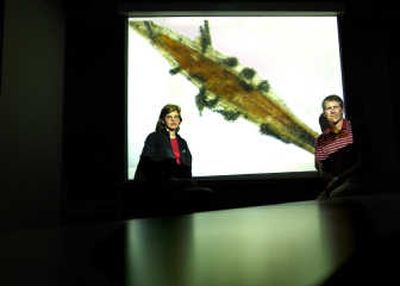‘Death’ fungus offers hope

It sounds like a 1950s horror flick: The Black Fingers of Death. But a tiny organism with this nickname is being cultivated at a Gonzaga University laboratory in hopes of being the first long-term weapon against cheatgrass – a very real and scary alien invader that’s infested some 100 million acres across the West.
Gonzaga biologists Julie Beckstead and David Boose were recently awarded $247,000 in federal grants to conduct a three-year study on the black fingers of death, a naturally occurring fungus that attacks the seeds of cheatgrass.
“We’re really excited about the potential of this organism,” said Beckstead, an associate professor who observed the dark, finger-like Pyrenophora semeniperda fungus poking out of cheatgrass seeds in 1992.
After the soil fungus attacks and kills cheatgrass seeds, it sends out black, stubby tendrils loaded with spores, thus the nickname, Beckstead said. “We had to call it something.”
Although most people only know cheatgrass from the prickly seeds that get stuck in their socks and on dog fur, the exotic weed from the steppes of Russia is having devastating consequences across the West. The low-growing grass not only crowds out native grasses, shrubs and flowers, it’s also providing the explosively dry fuel for the region’s massive fires, said Pam Camp, a botanist with the Bureau of Land Management’s office in Wenatchee.
Before the arrival of cheatgrass, the sagebrush grasslands of the Columbia River Plateau typically were burned by wildfire every 40 to 120 years, Camp said. With cheatgrass, the fires now come through every five years or so. The plant is the first to begin growing in spring and the first to dry out. Thick mats of mature cheatgrass provide easy fuel for lightning or even hot exhaust pipes from vehicles.
The cheatgrass-fueled fires knock back the native plants, giving cheatgrass even more space the following year. Currently, only 2 to 12 percent of native Columbia shrub-stepped grassland remains intact in Washington, Camp said. Restoring cheatgrass-infested ground costs between $500 to $1,000 an acre.
“It’s not possible in our lifetimes,” Camp said, when asked about the prospect of restoring native prairie.
Although herbicides can be used on cheatgrass, the chemicals don’t kill the weed’s dormant seeds lying in the soil, and there’s also the risk of the herbicides drifting onto adjoining private crop or range land, said Bob Troiano, a natural resource specialist with the BLM’s Spokane office. Basically, cheatgrass is winning the war.
“It has a serious impact on grazing and forage production for wildlife,” Troiano said.
Although much testing and research remains to be done, the black fingers of death could serve as an effective control against cheatgrass, Beckstead said. The organism can already be found on cheatgrass seeds across the West – including in weedy, vacant lots in Spokane – but it’s more common in certain places. The Gonzaga scientists plan to work with colleagues at Brigham Young University and the U.S. Forest Service’s Rocky Mountain Research Station in Provo, Utah, to better understand the fungus, including its effect on native plants.
Ideally, the fungus could be grown in large quantities and spread across infested sites, Beckstead said. The fact that the fungus is already found here might speed up the approval and research process, but Beckstead said it will likely take another decade of work before large quantities of the black fingers of death could be unleashed upon the West’s cheatgrass.
“The need to replant burns and replace cheatgrass is huge,” said Beckstead, who has taught at Gonzaga since 2002. “If we don’t do something there will be more and more cheatgrass and more and more fires.”